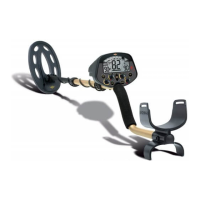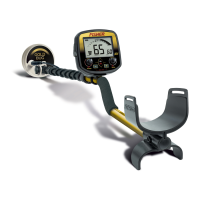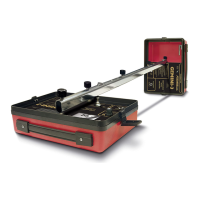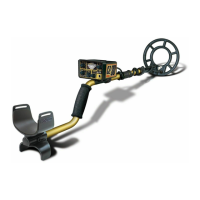LCD VISUAL DISPLAY (continued)
Since different metal objects can produce similar signals, and since minerals in the soil can
distort the signals, the probable target ID's are just that -- probable. There is no way of
knowing for sure what's buried other than to dig it up. Experienced metal detector users
have a rule of thumb -- "when in doubt, dig".
TARGET INDICATORS
The target indicators are at the top edge of the display. When a target is detected, a
rectangle-like indicator will illuminate over the target category corresponding to the
target’s electrical characteristics.
DEPTH
When the trigger is pulled to facilitate pinpointing an object, the numerical display
indicates the approximate depth of the object, in inches, based on the assumption that the
object is a typical U.S. coin. Small objects will read deeper than they actually are, and
large objects will usually read shallower than they actually are.
The DEPTH bar graph on the left of the display divides target depth into shallow, medium,
and deep. This depth range appears while searching, and is less accurate than the value
derived using the pinpoint toggle switch.
Bar graph ranges for a coin-sized object are Shallow (0-4inches), Medium (4-8inches), and
Deep (8inches +).
CONF (Target Confidence Indicator)
This 6-segment graphic indicates how confident the detector is of the 2-digit target
identification it has assigned. If all 6 segments are displayed, you can be confident that the
target ID is accurate. If 3 or fewer segments are displayed, the confidence is very low.
Junk targets tend to produce lower confidence indications than coin targets of similar
electrical conductivity. Sloppy sweep technique also reduces the confidence indication.
You can use this indicator to train yourself to sweep more skillfully.
Fe
3
O
4
BAR GRAPH (magnetite)
This bar graph displays the magnetic mineralization factor, or magnetic susceptibility, of
the soil. Magnetic susceptibility is expressed in terms of the percent volume of the iron
mineral magnetite, which most black sand is made of. The depth to which objects can be
accurately identified is strongly influenced by the magnetic susceptibility of the soil. High
Fe
3
O
4
values have a greater effect on detection depth in the Discrimination mode than in
the All Metal mode. For the most accurate Fe
3
O
4
reading, pump the searchcoil as though
you were ground balancing.
Fe
3
O
4
approx.
Range micro-cgs Description
3 7,500 uncommon but not rare, heavy mineralization
1 2,500 heavy mineralization, not uncommon in goldfields
0.3 750 heavy mineralization, but not uncommon in some regions
0.1 250 medium mineralization, typical
0.03 75 light mineralization, but common
0.01 25 light mineralization, often low G.B. setting
blank <14 quartz & coral white beach sands
